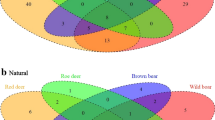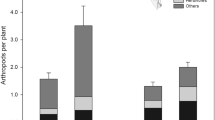Abstract
Herbivores may enhance plant recruitment, but such positive interactions may be overlooked in favour of obvious negative effects of herbivory on propagules. My objective was to determine whether larval insects that feed and develop within fruit of the mangrove Avicennia marina act as mutualist herbivores by increasing the dispersal of propagules without affecting their viability and emerging successfully as adults following dispersal of the propagule by water. Surveys revealed that frugivory is common throughout the mangrove forest, and fruit had up to six exit holes where larvae had emerged as adults. Larval insects did not affect the flotation of propagules with pericarps, a thin structure that provides buoyancy for dispersal by water. In contrast, after simulating germination by removing the pericarp, the majority of propagules with three exit holes floated on average for 20 h longer than those without exit holes, which sank immediately. Based on this evidence that frugivory could increase the dispersal potential of propagules, I predicted that propagules consumed by larval insects should disperse farther than undamaged propagules, and this was tested by quantifying the potential viability of propagules stranded on beaches at increasing distances (up to 20 km) from mangrove forests. Flies and moths emerged as adults after being transported tens of kilometres within mangrove propagules, revealing a novel mode of dispersal. Proportionally fewer potentially viable propagules were supplied to beaches at increasing distances from mangrove forests, however, indicating that larval insects negatively affect recruitment and are thus not acting as mutualist herbivores. Nevertheless, when transported back to the mangrove forest, seedlings established from propagules damaged by larval insects and stranded on beaches. Therefore, although frugivory does not preclude mangrove recruitment, its negative effects in the pre-dispersal environment may be intensified with increasing dispersal distance, thus limiting the long-distance supply of propagules and recruitment of mangroves.





Similar content being viewed by others
References
Allen JA, Krauss KW, Hauff RD (2003) Factors limiting the intertidal distribution of the mangrove species Xylocarpus granatum. Oecologia 135:110–121
Burns BR, Ogden J (1985) The demography of the temperate mangrove [Avicennia marina (Forsk.) Vierh.] at its southern limit in New Zealand. Aust J Ecol 10:125–133
Cavers PB (1983) Seed demography. Can J Bot 61:3578–3590
Chambers JC, MacMahon JA (1994) A day in the life of a seed: movements and fates of seeds and their implications for natural and managed systems. Annu Rev Ecol Syst 25:263–292
Clarke PJ (1992) Predispersal mortality and fecundity in the grey mangrove (Avicennia marina) in southeastern Australia. Aust J Ecol 17:161–168
Clarke PJ (1993) Dispersal of grey mangrove (Avicennia marina) propagules in southeastern Australia. Aquat Bot 45:195–204
Clarke PJ (1995) The population dynamics of the mangrove shrub Aegiceras corniculatum (Myrsinaceae): fecundity, dispersal, establishment and population structure. Proc Linn Soc NSW 115:35–44
Clarke PJ (2004) Effects of experimental canopy gaps on mangrove recruitment: lack of habitat partitioning may explain stand dominance. J Ecol 92:203–213
Clarke PJ, Allaway WG (1993) The regeneration niche of the grey mangrove (Avicennia marina): effects of salinity, light and sediment factors on establishment, growth and survival in the field. Oecologia 93:548–556
Clarke PJ, Myerscough PJ (1991a) Buoyancy of Avicennia marina propagules in south-eastern Australia. Aust J Bot 39:77–83
Clarke PJ, Myerscough PJ (1991b) Floral biology and reproductive phenology of Avicennia marina in south-eastern Australia. Aust J Bot 39:283–293
Clarke PJ, Myerscough PJ (1993) The intertidal distribution of the grey mangrove (Avicennia marina) in southeastern Australia: the effects of physical conditions, interspecific competition, and predation on propagule establishment and survival. Aust J Ecol 18:307–315
Clarke PJ, Kerrigan RA, Westphal CJ (2001) Dispersal potential and early growth in 14 tropical mangroves: do early life history traits correlate with patterns of adult distribution? J Ecol 89:648–659
Common IFB (1990) Moths of Australia. Melbourne University Press, Melbourne
Crawley MJ (1989) Insect herbivores and plant population dynamics. Annu Rev Entomol 34:531–564
Crawley MJ (1992) Seed predators and plant population dynamics. In: Fenner M (ed) Seeds: the ecology of regeneration in plant communities. CAB International, Wallingford, pp 157–192
Duke NC (1990) Phenological trends with latitude in the mangrove tree Avicennia marina. J Ecol 78:113–133
Farnsworth EJ, Ellison AM (1997) Global patterns of pre-dispersal propagule predation in mangrove forests. Biotropica 29:318–330
Fenner M (ed) (1992) Seeds: the ecology of regeneration in plant communities. CAB International, Wallingford, pp 157–192
Guppy HB (1882) The gizzard contents of some oceanic birds. Nature 26:12
Hemminga MA, van Soelen J, Koutstaal BP (1990) Tidal dispersal of salt marsh insect larvae within the Westerschelde estuary. Holarctic Ecol 13:308–315
Hockey MJ, De Baar M (1991) Some records of moths (Lepidoptera) from mangroves in southern Queensland. Aust Entomol Mag 19:57–60
Hutchings PA, Recher HF (1974) The fauna of Careel Bay with comments on the ecology of mangrove and sea-grass communities. Aust Zool 18:99–128
Hutchings PA, Recher HF (1982) The fauna of Australian mangroves. Proc Linn Soc NSW 106:83–121
Ingólfsson A (1995) Floating clumps of seaweed around Iceland: natural microcosms and a means of dispersal for shore fauna. Mar Biol 122:13–21
Janzen DH (1971) Seed predation by animals. Annu Rev Ecol Syst 2:465–492
Jordano P (1992) Fruits and frugivory. In: Fenner M (eds) Seeds: the ecology of regeneration in plant communities. CAB International, Wallingford, pp 105–156
Louda SM (1982) Distribution ecology: variation in plant recruitment over a gradient in relation to insect seed predation. Ecol Monogr 52:25–51
Louda SM (1983) Seed predation and seedling mortality in the recruitment of a shrub, Haplopappus venetus (Asteraceae), along a climatic gradient. Ecology 64:511–521
Louda SM (1989) Predation in the dynamics of seed regeneration. In: Leck MA, Parker VT, Simpson RL (eds) Ecology of soil seed banks. Academic Press, New York, pp 25–51
McAlpine DK (1965) New fruit-fly found on mangroves. Aust Nat Hist 15:60
McGuinness KA (1997a) Seed predation in a tropical mangrove forest: a test of the dominance-predation model in northern Australia. J Trop Ecol 13:293–302
McGuinness KA (1997b) Dispersal, establishment and survival of Ceriops tagal propagules in a north Australian mangrove forest. Oecologia 109:80–87
McKee KL (1995) Mangrove species distribution and propagule predation in Belize: an exception to the dominance-predation hypothesis. Biotropica 27:334–345
Minchinton TE (2001) Canopy and substratum heterogeneity influence recruitment of the mangrove Avicennia marina. J Ecol 89:888–902
Minchinton TE, Dalby-Ball M (2001) Frugivory by insects on mangrove propagules: effects on the early life history of Avicennia marina. Oecologia 129:243–252
Murphy DH (1990) The natural history of insect herbivory on mangrove trees in and near Singapore. Raffles Bull Zool 38:119–203
Onuf CP, Teal JM, Valiela I (1977) Interactions of nutrients, plant growth and herbivory in a mangrove ecosystem. Ecology 58:514–526
Peck SB (1994) Sea-surface (pleuston) transport of insects between islands in the Galápagos Archipelago, Ecuador. Ann Entomol Soc Am 87:576–582
Permkam S (1993) A revision of the Australian Trypetinae (Diptera: Tephritidae). PhD thesis, University of Queensland
Permkam S, Hancock DL (1995) Australian Trypetinae (Diptera: Tephritidae). Invertebr Taxon 9:1047–1209
Rabinowitz D (1977) Effects of a mangrove borer, Poecilips rhizophorae, on propagules of Rhizophora harrisonii in Panamá. Fla Entomol 60:129–134
Rabinowitz D (1978) Dispersal properties of mangrove propagules. Biotropica 10:47–57
Robertson AI (1991) Plant–animal interactions and the structure and function of mangrove forest ecosystems. Aust J Ecol 16:433–443
Robertson AI, Giddons R, Smith TJ (1990) Seed predation by insects in tropical mangrove forests: extent and effects on seed viability and the growth of seedlings. Oecologia 83:213–219
Santelices B, Correa J (1985) Differential survival of macroalgae to digestion by intertidal herbivore molluscs. J Exp Mar Biol Ecol 88:183–191
Smith TJ III (1987) Seed predation in relation to tree dominance and distribution in mangrove forests. Ecology 68:266–273
Smith TJ III (1992) Forest structure. In: Robertson AI, Alongi DM (eds) Coastal and estuarine studies no. 41. Tropical mangrove ecosystems. American Geophysical Union, Washington, D.C., pp 101–136
Sousa WP, Mitchell BJ (1999) The effect of seed predators on plant distributions: is there a general pattern in mangroves? Oikos 86:55–66
Sousa WP, Kennedy PG, Mitchell BJ (2003) Propagule size and predispersal damage by insects affect establishment and early growth of mangrove seedlings. Oecologia 135:564–575
Steinke TD (1986) A preliminary study of buoyancy behaviour in Avicennia marina propagules. S Afr J Bot 52:559–565
Stiles EW (1992) Animals as seed dispersers. In: Fenner M (ed) Seeds: the ecology of regeneration in plant communities. CAB International, Wallingford, pp 87–104
Tomlinson PB (1994) The botany of mangroves. Cambridge University Press, New York
West RJ, Thorogood C, Walford T, Williams RJ (1985) An estuarine inventory for New South Wales, Australia. Fish Bull 2
Acknowledgements
I am grateful to Peter Clarke and Surakrai Permkam for sharing their insights on the natural history of insects living in mangrove forests. I thank David McAlpine of the Australian Museum for identifying the insects and Mia Dalby-Ball for help in the field. Cynthia Hays and George Leonard provided thoughtful comments on an earlier draft of this manuscript. Thanks to the NSW National Parks and Wildlife Service for permits to work at the Towra Point Aquatic Reserve. Funding was provided by the University of Wollongong, the Australian Research Council, and the Natural Sciences and Engineering Research Council of Canada.
Author information
Authors and Affiliations
Corresponding author
Additional information
Communicated by Christian Koerner
Rights and permissions
About this article
Cite this article
Minchinton, T.E. Consequences of pre-dispersal damage by insects for the dispersal and recruitment of mangroves. Oecologia 148, 70–80 (2006). https://doi.org/10.1007/s00442-005-0351-6
Received:
Accepted:
Published:
Issue Date:
DOI: https://doi.org/10.1007/s00442-005-0351-6




